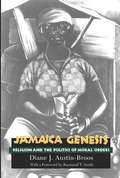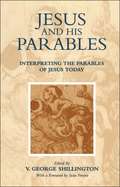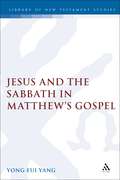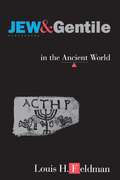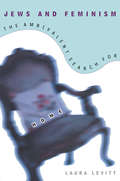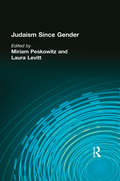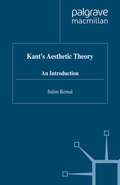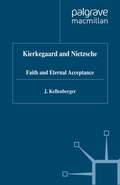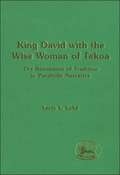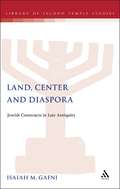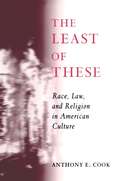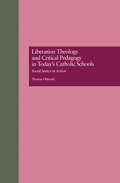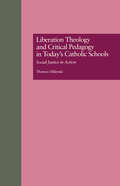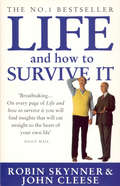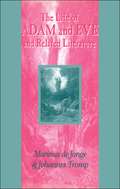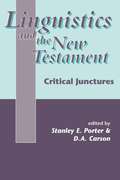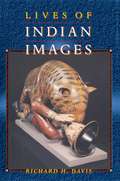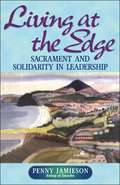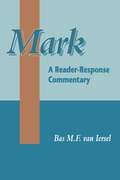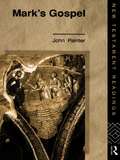- Table View
- List View
Jamaica Genesis: Religion and the Politics of Moral Orders
by Diane J. Austin-BroosHow has Pentecostalism, a decidedly American form of Christian revivalism, managed to achieve such phenomenal religious ascendancy in a former British colony among people of predominately African descent? According to Diane J. Austin-Broos, Pentecostalism has flourished because it successfully mediates between two historically central yet often oppositional themes in Jamaican religious life—the characteristically African striving for personal freedom and happiness, and the Protestant struggle for atonement and salvation through rigorous ethical piety. With its emphasis on the individual experience of grace and on the ritual efficacy of spiritual healing, and with its vibrantly expressive worship, Jamaican Pentecostalism has become a powerful and compelling vehicle for the negotiation of such fundamental issues as gender, sexuality, race, and class. Jamaica Genesis is a work of signal importance to all those concerned not simply with Caribbean studies but with the ongoing transformation of religion andculture.
Jamaica Genesis: Religion and the Politics of Moral Orders (The\bush School Series In The Economics Of Public Policy)
by Diane J. Austin-BroosHow has Pentecostalism, a decidedly American form of Christian revivalism, managed to achieve such phenomenal religious ascendancy in a former British colony among people of predominately African descent? According to Diane J. Austin-Broos, Pentecostalism has flourished because it successfully mediates between two historically central yet often oppositional themes in Jamaican religious life—the characteristically African striving for personal freedom and happiness, and the Protestant struggle for atonement and salvation through rigorous ethical piety. With its emphasis on the individual experience of grace and on the ritual efficacy of spiritual healing, and with its vibrantly expressive worship, Jamaican Pentecostalism has become a powerful and compelling vehicle for the negotiation of such fundamental issues as gender, sexuality, race, and class. Jamaica Genesis is a work of signal importance to all those concerned not simply with Caribbean studies but with the ongoing transformation of religion andculture.
Jamaica Genesis: Religion and the Politics of Moral Orders
by Diane J. Austin-BroosHow has Pentecostalism, a decidedly American form of Christian revivalism, managed to achieve such phenomenal religious ascendancy in a former British colony among people of predominately African descent? According to Diane J. Austin-Broos, Pentecostalism has flourished because it successfully mediates between two historically central yet often oppositional themes in Jamaican religious life—the characteristically African striving for personal freedom and happiness, and the Protestant struggle for atonement and salvation through rigorous ethical piety. With its emphasis on the individual experience of grace and on the ritual efficacy of spiritual healing, and with its vibrantly expressive worship, Jamaican Pentecostalism has become a powerful and compelling vehicle for the negotiation of such fundamental issues as gender, sexuality, race, and class. Jamaica Genesis is a work of signal importance to all those concerned not simply with Caribbean studies but with the ongoing transformation of religion andculture.
Jesus and his Parables: Interpreting the Parables of Jesus Today
by V. George ShillingtonA complete range of modern approaches to interpreting the parables. Not only a textbook, but readable and accessible and as engaging to the general reader as to the scholar and minister.
Jesus and the Sabbath in Matthew's Gospel (The Library of New Testament Studies #139)
by Yong-Eui YangMatthew's two stories of sabbath controversy contain key materials on the relations between Jesus and the sabbath. Deploying both socio-historical and literary criticisms, the author concludes that for Matthew the sabbath is fulfilled by Jesus-that is to say, Jesus' redemption has fulfilled the ultimate goal for the sabbath. The christological and eschatological character of these stories is thus apparent, and Yang suggests that such an emphasis, over against the Pharisees' casuistic concerns, betrays Matthew's awareness of the danger of a legalistic tendency in sabbath observance among members of his community.
Jew and Gentile in the Ancient World: Attitudes and Interactions from Alexander to Justinian
by Louis H. FeldmanRelations between Jews and non-Jews in the Hellenistic-Roman period were marked by suspicion and hate, maintain most studies of that topic. But if such conjectures are true, asks Louis Feldman, how did Jews succeed in winning so many adherents, whether full-fledged proselytes or "sympathizers" who adopted one or more Jewish practices? Systematically evaluating attitudes toward Jews from the time of Alexander the Great to the fifth century A.D., Feldman finds that Judaism elicited strongly positive and not merely unfavorable responses from the non-Jewish population. Jews were a vigorous presence in the ancient world, and Judaism was strengthened substantially by the development of the Talmud. Although Jews in the Diaspora were deeply Hellenized, those who remained in Israel were able to resist the cultural inroads of Hellenism and even to initiate intellectual counterattacks. Feldman draws on a wide variety of material, from Philo, Josephus, and other Graeco-Jewish writers through the Apocrypha, the Pseudepigrapha, the Church Councils, Church Fathers, and imperial decrees to Talmudic and Midrashic writings and inscriptions and papyri. What emerges is a rich description of a long era to which conceptions of Jewish history as uninterrupted weakness and suffering do not apply.
Jews and Feminism: The Ambivalent Search for Home
by Laura LevittBy interrogating America's promise of a home for Jews as citizens of the liberal state, Jews and Feminism questions the very terms of this social "contract". Maintaining that Jews, women, and Jewish women are not necessarily secure within this construction of the state, Laura Levitt links this contractual construction of belonging and acceptance to legacies of marriage as a contractual home for Jewish women. Exploring the immigration of Jews from Eastern Europe for America, as well as their desire to make this country their permanent home, Levitt raises questions about the search for stability in specific Jewish religious and cultural traditions which is linked to the liberal academy as well as feminist study, thus offering an account of an ambivalent Jewish feminist embrace of America as home.
Jews and Feminism: The Ambivalent Search for Home
by Laura LevittBy interrogating America's promise of a home for Jews as citizens of the liberal state, Jews and Feminism questions the very terms of this social "contract". Maintaining that Jews, women, and Jewish women are not necessarily secure within this construction of the state, Laura Levitt links this contractual construction of belonging and acceptance to legacies of marriage as a contractual home for Jewish women. Exploring the immigration of Jews from Eastern Europe for America, as well as their desire to make this country their permanent home, Levitt raises questions about the search for stability in specific Jewish religious and cultural traditions which is linked to the liberal academy as well as feminist study, thus offering an account of an ambivalent Jewish feminist embrace of America as home.
Judaism Since Gender
by Miriam Peskowitz Laura LevittJudaism Since Gender offers a radically new concept of Jewish Studies, staking out new intellectual terrain and redefining the discipline as an intrinsically feminist practice. The question of how knowledge is gendered has been discussed by philosophers and feminists for years, yet is still new to many scholars of Judaism. Judaism Since Gender illuminates a crucial debate among intellectuals both within and outside the academy, and ultimately overturns the belief that scholars of Judaism are still largely oblivious of recent developments in the study of gender. Offering a range of provocations--Jewish men as sissies, Jesus as transvestite, the problem of eroticizing Holocaust narratives--this timely collection pits the joys of transgression against desires for cultural wholeness.
Judaism Since Gender
by Miriam Peskowitz Laura LevittJudaism Since Gender offers a radically new concept of Jewish Studies, staking out new intellectual terrain and redefining the discipline as an intrinsically feminist practice. The question of how knowledge is gendered has been discussed by philosophers and feminists for years, yet is still new to many scholars of Judaism. Judaism Since Gender illuminates a crucial debate among intellectuals both within and outside the academy, and ultimately overturns the belief that scholars of Judaism are still largely oblivious of recent developments in the study of gender. Offering a range of provocations--Jewish men as sissies, Jesus as transvestite, the problem of eroticizing Holocaust narratives--this timely collection pits the joys of transgression against desires for cultural wholeness.
Kant’s Aesthetic Theory: An Introduction
by S. KemalThis authoritative and accessible book explains the argument and strategy of Kant's analysis of beauty. A number of issues are discussed - amongst them the distinction and relation between natural beauty and fine art, pure and dependent beauty, disinterestedness and universality, form and expression, beauty and morality, transcendental and empirical necessity, individual and community. Links are also forged between Kant's theory and contemporary commentaries - including those by Donald Crawford, Jacques Derrida, Paul Guyer, Rudolph Makkreel, Mary McCloskey, Kenneth Rogerson and John Zammito.
Kierkegaard and Nietzsche: Faith and Eternal Acceptance (Library of Philosophy and Religion)
by J. KellenbergerThis book examines the thinking of two nineteenth-century existentialist thinkers, Soren Kierkegaard and Friedrich Nietzsche. Its focus is on the radically different ways they envisioned a joyful acceptance of life - a concern they shared. For Kierkegaard, in Fear and Trembling, joyful acceptance flows from the certitude of faith. For Nietzsche, in Thus Spoke Zarathustra, joyful acceptance is an acceptance of the eternal recurrence of life, and is ultimately a matter of will. This book explores the relationship between these opposed visions.
King David with the Wise Woman of Tekoa: The Resonance of Tradition in Parabolic Narrative (The Library of Hebrew Bible/Old Testament Studies)
by Larry LykeAssesses the multivocal quality of 2 Samuel 14 as a result of the many historical and social processes that formed the Hebrew Bible as a whole.
Land, Center and Diaspora: Jewish Constructs in Late Antiquity (The Library of Second Temple Studies #21)
by Isaiah GafniThe unique duality of Jewish existence, wherein a major Jewish centre in the Land of Israel flourished alongside a large and prosperous diaspora, was one of the outstanding features of Second Temple and post-Temple Jewish life. As in modern times, ongoing Jewish dispersion raised questions that went to the heart of Jewish self-identity, and declarations of allegiance to the ancestral homeland were frequently accompanied by seemingly contrary expressions of 'local-patriotism' on the part of Jewish diaspora communities. The destruction of Jerusalem and its Temple in 70 CE, and the subsequent failure under Bar-Kokhba to revive political independence (135 CE) forced Jews in Judaea as well as in the diaspora to re-evaluate the nature of the bonds that linked Jews throughout the world to 'The Land', and at the same time effected a re-examination of the authority structure that claimed priority for the communal leaders still functioning in Jewish Palestine. The chapters of this book, first delivered in Oxford as the Third Jacobs Lectures in Rabbinic Thought in January 1994, address a broad spectrum of questions relating to the centre-diaspora reality of Jewish life in Late Antiquity.
The Least of These: Race, Law, and Religion in American Culture
by Anthony E. CookFirst published in 1997. Routledge is an imprint of Taylor & Francis, an informa company.
The Least of These: Race, Law, and Religion in American Culture
by Anthony E. CookFirst published in 1997. Routledge is an imprint of Taylor & Francis, an informa company.
Liberation Theology and Critical Pedagogy in Today's Catholic Schools: Social Justice in Action (Critical Education Practice)
by Thomas OldenskiGrounded in the work of liberation theologians, this book considers peace, love and social justice within a democratic curriculum and underscores the importance of integrating critical discourses with Catholic education.
Liberation Theology and Critical Pedagogy in Today's Catholic Schools: Social Justice in Action (Critical Education Practice #Vol. 11)
by Thomas OldenskiGrounded in the work of liberation theologians, this book considers peace, love and social justice within a democratic curriculum and underscores the importance of integrating critical discourses with Catholic education.
Life And How To Survive It
by John Cleese Dr Robin SkynnerBrilliantly entertaining, enlightening and inspiring, Robin Skynner and John Cleese take on the big issue: life, and the challenge of living, in all its myriad forms. This book is an essential guide to surviving life's ups and downs - at home or in the workplace, as a member of a family or society. Presented in the same lively style as the best-selling Families and How to Survive Them, Life extends Skynner's and Cleese's study beyond the family to relationships and group interaction in life outside it. The book deals with such pithy issues as: -Why life gives you all the lessons you need-How grief can be good for you-Why work is essential to our psychological health-What mid-life crisis means for youWe are all searching for healthier, happier, more satisfying lives, but it's the journey that matters, not the destination. Skynner and Cleese are the perfect travelling companions.
Life of Adam and Eve and Related Literature (Guides to the Apocrypha and Pseudepigrapha)
by Marinus De Jonge Johannes TrompThe Life of Adam and Eve once belonged to the most popular literature in the Christian world. Retelling the Genesis 3 story, it gives an elaborate description of Adam's death and his assumption to Paradise in the third heaven. His continued existence, as well as his future resurrection, are as much a paradigm for humanity as his transgression, condemnation and death. For a long time attention was focused on the Greek and Latin versions only. More recently, editions of Georgian and Armenian versions have become available, occupying a middle position between the Greek and the Latin. This new material now makes it necessary to sort out the relationships between no less than five clearly related but in many respects different documents. Taken together they present a complex but interesting mosaic of reflections on the human plight, inspired by the Genesis story.
Linguistics and the New Testament: Critical Junctures (The Library of New Testament Studies #168)
by Stanley E. Porter D. A. CarsonThis volume continues the major work published by the JSNT Supplement Series in the area of Greek linguistics of the New Testament, and explores what the editors believe are crucial phases in the application of linguistics to New Testament Greek. The first half of the volume includes essays on such topics as linguistics and literary criticism, linguistics and historical criticism, and linguistics and rhetoric. The second half includes essays dealing with the relations and uses of individual words, but ranges from oral composition to the value of word frequency in determining authorship. Some of these essays review established models of research; others propose new models and criteria of linguistic analysis.
Lives of Indian Images
by Richard H. DavisFor many centuries, Hindus have taken it for granted that the religious images they place in temples and home shrines for purposes of worship are alive. Hindu priests bring them to life through a complex ritual "establishment" that invokes the god or goddess into material support. Priests and devotees then maintain the enlivened image as a divine person through ongoing liturgical activity: they must awaken it in the morning, bathe it, dress it, feed it, entertain it, praise it, and eventually put it to bed at night. In this linked series of case studies of Hindu religious objects, Richard Davis argues that in some sense these believers are correct: through ongoing interactions with humans, religious objects are brought to life.Davis draws largely on reader-response literary theory and anthropological approaches to the study of objects in society in order to trace the biographies of Indian religious images over many centuries. He shows that Hindu priests and worshipers are not the only ones to enliven images. Bringing with them differing religious assumptions, political agendas, and economic motivations, others may animate the very same objects as icons of sovereignty, as polytheistic "idols," as "devils," as potentially lucrative commodities, as objects of sculptural art, or as symbols for a whole range of new meanings never foreseen by the images' makers or original worshipers.
Living at the Edge: Sacrament and Solidarity in Leadership
by Penny JamiesonAs the first woman in the Anglican Communion to become a diocesan bishop, she brought to her diocese an experience of beng an outsider, a woman in a hierarchical church in which women were second class citizens. In this, her first book, she asks how outsiders who win power may exercise that power without making others outsiders.
Mark: A Reader-Response Commentary (The Library of New Testament Studies #164)
by Bas M. van IerselThe distinguished Dutch New Testament scholar Bas van Iersel offers us an incisive and comprehensive episode-by-episode commentary on the Gospel of Mark. His special focus is on the contribution of each episode to the overall meaning of the gospel, at both the level of the story and the level of the discourse. As a reader-response commentator, his concern is everywhere with the effect of Mark's story on its readers, engaging both with the situation of the original audience of Mark-Christians of Gentile origin in Rome shortly after the Neronian persecutions-and with that of the present-day reader. Even the introductions are reader-related: on the role of the reader, the original audience and the reader of today, the overall concentric structure of Mark, and the relation of Mark to the Old Testament.
Mark's Gospel
by John PainterMark's 'biography' of Jesus is the earliest of the four gospels, and influenced them all. The distinctive feature of this biography is the quality of 'good news', which presupposes a world dominated by the forces of evil.John Painter shows how the rhetorical and dramatic shaping of the book emphasises the conflict of good and evil at many levels - between Jesus and the Jewish authorities, Jesus and the Roman authorities, and the conflict of values within the disciples themselves. These matters of content are integral to this original approach to Mark's theodicy, while the stylistic issue raises the question of Mark's intended readership.John Painter's succinct yet thorough treatment of Mark's gospel opens up not only these rhetorical issues, but the social context of the gospel, which Painter argues to be that of the Pauline mission to the nations.
